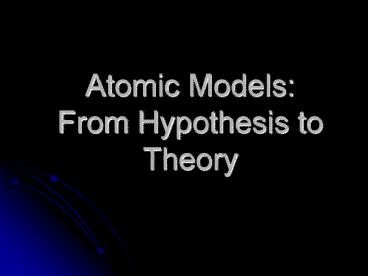Atomic Models: From Hypothesis to Theory - PowerPoint PPT Presentation
1 / 30
Title:
Atomic Models: From Hypothesis to Theory
Description:
Title: Atomic Models: Developing the Structure of the Atom Last modified by: Mac User Document presentation format: On-screen Show (4:3) Company – PowerPoint PPT presentation
Number of Views:197
Avg rating:3.0/5.0
Title: Atomic Models: From Hypothesis to Theory
1
Atomic ModelsFrom Hypothesis to Theory
2
- http//www.youtube.com/watch?vbw5TE5o7JtEfeature
BFalistPLE2B5C43C0BC88688lfresults_main
3
The Greek Model
- 440 BC Leucippus Democritus hypothesize that
matter is made of atoms - Explained why different substances have different
properties - Performed no experiments
- Very little evidence to support hypothesis
Democritus of Abdera
4
The Greek Model
- Five major points
- All matter is composed of atoms
- too small to be seen
- CANNOT be split into smaller parts
- There is a void, which is empty space between
atoms - Atoms are completely solid
- Atoms are homogeneous, with no internal structure
- Atoms are different in size, shape, and weight
5
The Dalton Model
- 1803 John Dalton (England) re-introduced the
atomic idea to modern chemistry - Dalton and other chemists did experiments
involving gases and how they combine - They noticed that elements always seemed to
combine in the same ratios (such as 11, 12, 23
etc)
6
(No Transcript)
7
Daltons Atom, 1807
- To explain these observations, Dalton
hypothesized that - Chemical elements are made of atoms
- The atoms of the same element have the same mass
- Atoms of different elements have different masses
(but the same general shape) - Atoms are involved in chemical reactions but are
not changed by them - Characteristics of Daltons atom
- uniformly dense
- indivisible
- solid spheres
8
The Thomson Model
- 1897 J.J. Thomson hypothesized that there are
areas of negative charge (electrons) within the
atom - Based on experimental observations
- Called the Plum Pudding Model
9
Discovery of the Electron
10
Rutherfords Gold Foil Experiment
- Rutherford shot alpha particles at gold foil
- expected the alpha particles to go through the
gold foil but be deflected- most particles did - Some alpha particles werent deflected, they
bounced back! - He said It was almost as incredible as if you
fired a 15-inch shell at a piece of tissue paper
and it came back and hit you."
11
(No Transcript)
12
The Rutherford Model, 1911
- Atomic theory was revised to explain Rutherfords
observations - Rutherfords Model stated
- The atom contains a tiny dense center called the
nucleus - the volume of the nucleus is about 1/10
trillionth the volume of the atom - The nucleus is essentially the entire mass of the
atom (the rest is mostly empty space)
13
The Rutherford Model, 1911
- Rutherfords Model stated
- The nucleus is positively charged
- The amount of positive charge of the nucleus
balances the negative charge of the electrons - The electrons move around in
- the empty space of the atom
- surrounding the nucleus
e-
3p
e-
e-
14
Discovery of the Nucleus
- http//www.youtube.com/watch?vwzALbzTdnc8
15
The Bohr Model
- Niels Bohr
- applies quantum theory to Rutherford's atomic
structure - led to the idea of electrons moving around the
nucleus in orbits or energy levels - emission of light occurs when an electron moves
into a lower energy orbit.
16
Bohrs Research
- Electron orbit around the nucleus in seven
different energy levels, or shells. - Electrons would only occupy the lowest possible
energy level. - Electrons would only move up a level (increasing
energy) if the lower levels were full.
17
Atomic Scale
18
Modern Atomic Theory
- An updated version of Bohrs model
- Electrons move in 3-D clouds rather than orbits
- There are three
- types of particles
- in the atom rather
- than two
19
Subatomic Particles
Particle Charge Mass (kg) Relative Mass Location
20
Subatomic Particles
Particle Charge Mass (kg) Relative Mass Location
Proton
Neutron
Electron
21
Subatomic Particles
Particle Charge Mass (kg) Relative Mass Location
Proton 1
Neutron
Electron
22
Subatomic Particles
Particle Charge Mass (kg) Relative Mass Location
Proton 1
Neutron 0
Electron
23
Subatomic Particles
Particle Charge Mass (kg) Relative Mass Location
Proton 1
Neutron 0
Electron -1
24
Subatomic Particles
Particle Charge Mass (kg) Relative Mass Location
Proton 1 1.67x10-27 1
Neutron 0 1.67x10-27
Electron -1 9.11x10-31
25
Subatomic Particles
Particle Charge Mass (kg) Relative Mass Location
Proton 1 1.67x10-27 1
Neutron 0 1.67x10-27 1
Electron -1 9.11x10-31
26
Subatomic Particles
Particle Charge Mass (kg) Relative Mass Location
Proton 1 1.67x10-27 1
Neutron 0 1.67x10-27 1
Electron -1 9.11x10-31 0
27
Subatomic Particles
Particle Charge Mass (kg) Relative Mass Location
Proton 1 1.67x10-27 1 Nucleus
Neutron 0 1.67x10-27 1
Electron -1 9.11x10-31 0
28
Subatomic Particles
Particle Charge Mass (kg) Relative Mass Location
Proton 1 1.67x10-27 1 Nucleus
Neutron 0 1.67x10-27 1 Nucleus
Electron -1 9.11x10-31 0
29
Subatomic Particles
Particle Charge Mass (kg) Relative Mass Location
Proton 1 1.67x10-27 1 Nucleus
Neutron 0 1.67x10-27 1 Nucleus
Electron -1 9.11x10-31 0 outside nucleus
30
- http//abyss.uoregon.edu/js/21st_century_science/
lectures/lec05.html - http//dl.clackamas.edu/ch104-04/dalton27s.htm
- http//abyss.uoregon.edu/js/21st_century_science/
lectures/lec11.html - http//galileo.phys.virginia.edu/classes/252/Ruthe
rford_Scattering/Rutherford_Scattering.html































